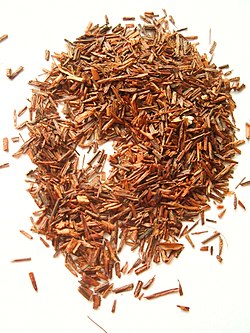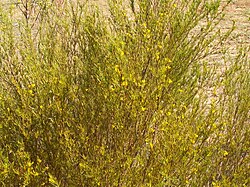Rooibos
| Rooibos | |
|---|---|

| |
| Scientific classification | |
| Kingdom: | |
| Division: | |
| Class: | |
| Order: | |
| Family: | |
| Genus: | |
| Species: | A. linearis
|
| Binomial name | |
| Aspalathus linearis (N.L.Burm.) R.Dahlgr.
| |



Template:FixHTML Rooibos, (Template:PronEng, like "roy-boss"), Afrikaans for "red bush"; scientific name Aspalathus linearis) is a broom-like member of the legume family of plants and is used to make a tisane (herbal tea). Commonly called South African red tea or simply red tea or bush tea, the product has been popular in South Africa for generations and is now consumed in many countries. It is sometimes spelled rooibosch in accordance with the Dutch etymology, but "roy-boss" remains the correct pronunciation.
Production
Rooibos is grown only in a small area in the Cederberg region of the Western Cape province.[1] Generally, the leaves are oxidized, a process often, and inaccurately, referred to as fermentation by analogy with tea processing terminology. This process produces the distinctive reddish-brown color of rooibos and enhances the flavour. Unoxidized "green" rooibos is also produced, but the more demanding production process for green rooibos (similar to the method by which green tea is produced) makes it more expensive than traditional rooibos.
Use
In South Africa it is more common to drink rooibos with milk and sugar, but elsewhere it is usually served without. The flavor of rooibos tea is often described as being sweet (without sugar added) and slightly nutty. Preparation of rooibos tea is essentially the same as black tea save that the flavour is improved by longer brewing. The resulting brew is a reddish brown color, explaining why rooibos is sometimes referred to as "red tea". Infact Rooibos translates to "Red Bush" in Afrikaans (The language of the Dutch descendents in Sout Africa).
Several coffee shops in South Africa have recently begun to sell red espresso[1], which is concentrated rooibos served and presented in the style of ordinary espresso (which is normally coffee-based). This has given rise to rooibos-based variations of coffee drinks such as red lattes and red cappuccinos.
Nutritional and health benefits
Rooibos is becoming more popular in Western countries particularly among health-conscious consumers, due to its high level of antioxidants such as aspalathin and nothofagin, its lack of caffeine, and its low tannin levels compared to fully oxidized black tea or unoxidized green tea leaves. [citation needed] "Green" rooibos (see above) has a higher antioxidant capacity than fully oxidised rooibos.
History
Although rooibos was first reported in 1772 by botanist Carl Thunberg, the Khoisan people of the area had been using it for a long time[citation needed] and were aware of its medicinal value[2]p. 52. The Dutch settlers to the Cape adopted rooibos as an alternative to black tea, an expensive commodity for the settlers who relied on supply ships from Europe. Until the 19th century, however, Dutch usage of the tea was minimal.
In 1903, Benjamin Ginsberg, a Russian settler to the Cape and descendant of a famous tea family, saw potential in rooibos and began trading with the local Khoisan people who were harvesting it. He sold his "Mountain Tea" to settlers in the Cape and shortly became the first exporter of rooibos using contacts from the family tea business.
In the 1930s, Ginsberg convinced a local doctor and Rhodes scholar, Dr. Peter Nortier[2]p. 52, to experiment with cultivation of the plant. Dr. Nortier cultivated the first plants at Clanwilliam on the Klein Kliphuis farm, owned by W.T. Riordan, a retired magistrate. The tiny seeds were difficult to obtain, as they dispersed as soon as the pods cracked, and would not germinate without scarifying. Dr. Nortier paid farmers to collect seeds. An aged Khoi woman had found a rather unusual source of supply. She came again and again, receiving a shilling for each matchbox filled with seed. She had chanced upon ants dragging seed one day, followed them back to their nest and, on breaking it open, found a granary[2]pp. 53-4. The attempts by Dr. Nortier were ultimately successful, which led Ginsberg to encourage local farmers to cultivate the plant in the hope that it would become a profitable venture. Klein Kliphuis became a tea farm, and within ten years the price of seeds soared to an astounding £80 a pound, the most expensive vegetable seed in the world. Today the seed is gathered by special sifting processes, and Klein Kliphuis [2] is now a guest farm.
Since then, rooibos has grown in popularity in South Africa, and has gained considerable momentum in the worldwide market too. A growing number of brand-name tea companies sell this tea, either by itself or as a component in an ever-growing variety of blends.
The popularity of rooibos has also gained from its association with Precious Ramotswe, the Tswana detective in Alexander McCall Smith's series of novels about The No. 1 Ladies' Detective Agency. Mma Ramotswe's favourite drink is red bush tea (rooibos), which she often promotes as a therapeutic drink to her friends and clients - and hence the readers of the books.
Trademark controversy
In 1994, Burke International registered the common name rooibos with the US Patent and Trademark Office, exploiting its status as virtually unknown in the US to establish a monopoly on the name in America. When the plant later entered more widespread use, it attempted to force companies to either pay fees for use of the name, or cease its use. After a decade, the American Herbal Products Association and a number of import companies finally succeeded in defeating this trademark through petitions and lawsuits, causing Burke to "voluntarily surrender" the name to the public domain after losing one of the ongoing cases.[3]
See also
References
- ^ Antimutagenic and Cancer-modulating Properties of Two Unique South African Herbal Teas, Rooibos and Honeybush, South African Medical Research Council website (accessed February 23, 2008)
- ^ a b c [Green, Lawrence: "In The Land of the Afternoon"] Standard Press Ltd. 1949
- ^ Rooibos Trademark Abandoned American Herbal Products Association (AHPA) press release, 2005-06-28
